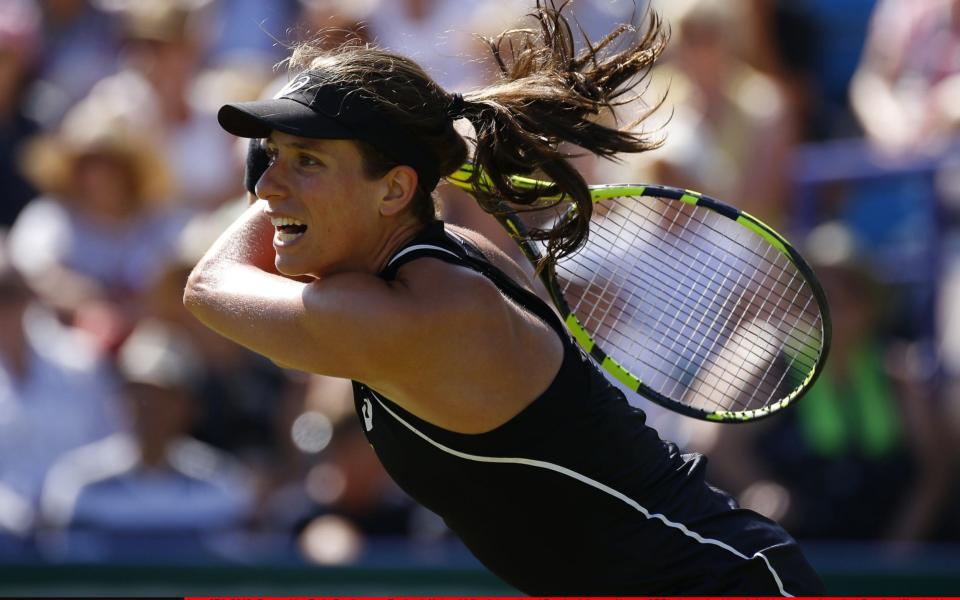Johanna Konta has finally shown her fiery side

It has taken a while for the façade to crack, but Johanna Konta is finally beginning to show what she is really thinking. Over the long term, this might just help her.
For context on the recent ructions in Konta’s world, we need to sketch in some history. When she first started her rapid ascent of the rankings, in the late summer of 2015, she was using a mental training system formulated by her “mind guru” Juan Coto to control her volcanic emotions.
Her focus on “process” – a word she never failed to use in any interview – enabled her to avoid the stress-related freak-outs that had previously made her a shaky closer. At the relatively mature age of 24, she was learning to turn her talent into titles.
READ MORE: Nadal unsure over Wimbledon prospects
READ MORE: Murray still on course for Wimbledon but feels ‘a little bit odd’
READ MORE: Wozniacki triumphs at Eastbourne as Sabalenka falters
But the old complexes were still there, bubbling away. In recent months, they have resurfaced. First, she started losing the close matches again, particularly against the best. (Konta comes into Wimbledon on a seven-match losing streak against top-ten players, five of which went to a deciding set.)
And then, she began to speak her mind. Having gone down to a straight-sets defeat in the first round of last month’s French Open, Konta referred to the assembled reporters as “bastards” and blamed media negativity for making her job more difficult.

A couple of weeks later, it was the court officials’ turn. Konta turned on the chair umpire after a duff call went against her late in the Nottingham final a fortnight ago. “You are making decisions that affect all our lives,” she raged, wagging her finger. “Do you fully understand that?"
Who, then, is the real Johanna Konta? She is extremely intelligent, with a first-rate work ethic, but lacking in soft skills. In a different life, her combination of brains and brittleness could have made her a lab scientist in a white coat.
Konta claims to have no superstitions but insiders suggest that this could not be further from the truth. And she has proved changeable in her treatment of backroom staff. Having sacked coach Esteban Carril at the end of her breakthrough season in 2016, she would then dismiss his successor Wim Fissette only a year later.
This instability fits with Konta’s persona on court, which was described as “fidgety and hyped and nervous” last week by the former Wimbledon champion Chris Evert.

“To me, she’s a nervous kind of player,” said Evert, who now commentates for the American broadcasters ESPN. “The top players play with sort of a relaxed freedom. They have the trust in their shots. I feel like she’s a little tense. She has to play with a new kind of freedom, see how that goes. It hasn’t worked this year with what she’s been doing.”
This last point would accord with Konta’s ranking, which has dropped from No. 7 a year ago to No. 22 now. Should she lose to Natalia Vikhlyantseva on Tuesday, and thus forfeit the 780 rankings points she claimed from her run to the semi-finals here last year, she could slide outside the top 50.
Yet there is a paradox here, because Konta is simultaneously in crisis and playing better tennis than we have seen from her in almost a year. The clay season is always a grind for her, as her one-paced game doesn’t fly well against opponents who can shape their shots through the use of creative spins. But once she gets onto the grass, her low, scudding groundstrokes start to fizz through the court with real venom.
Konta’s win-loss record since the French Open stands at 5-3. This might fall short of the 8-2 she recorded over the same period last season, but then in each of the events she lost to the eventual champion: Ashleigh Barty in Nottingham (in the final that featured her umpire run-in), Petra Kvitova in Birmingham and Caroline Wozniacki in Eastbourne.

She might have had the measure of Wozniacki, too, but for a blared forehand in the final stages of their three-set thriller. It wasn’t her tennis that let her down, exactly; more the tattered self-belief that stems from her indifferent recent results.
It is hard to know, then, which way things will develop for Konta in the next few days. A win over Vikhlyantseva, followed by further success in a tricky second round against Dominika Cibulkova or Alize Cornet, and some of her old composure should return. An early defeat, and she will do well to earn a seeding at the US Open in two months’ time.
Either way, Konta would probably benefit from letting out more of the broiling tension that lies behind her prim exterior. Not that she showed much interest in doing so yesterday. During her official pre-tournament appearance in the interview room, she wore such a broad and relaxed smile that she could have been part of one of Wimbledon’s tour groups, filing out into the Centre Court stands for selfies.
In her comments, Konta tried to frame Wimbledon as just one more tournament in a busy year. “We're very fortunate in tennis [because] we get to have an opportunity almost every week. There's still a whole second half of the season to play.”
But this is, unquestionably, the crux of her season. If we see a hint of the new, unbuttoned Konta in the coming days, that might be a blessing.

 Yahoo Sport
Yahoo Sport 






































